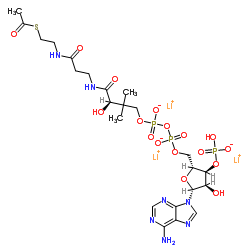Acetyl coenzyme A trilithium
Modify Date: 2025-08-24 09:55:48

Acetyl coenzyme A trilithium structure
|
Common Name | Acetyl coenzyme A trilithium | ||
|---|---|---|---|---|
| CAS Number | 75520-41-1 | Molecular Weight | 827.370 | |
| Density | N/A | Boiling Point | N/A | |
| Molecular Formula | C23H35Li3N7O17P3S | Melting Point | N/A | |
| MSDS | N/A | Flash Point | N/A | |
Use of Acetyl coenzyme A trilithiumAcetyl-coenzyme A (Acetyl-CoA) trilithium is a membrane-impermeant central metabolic intermediate, participates in the TCA cycle and oxidative phosphorylation metabolism. Acetyl-coenzyme A trilithium regulates various cellular mechanisms by providing (sole donor) acetyl groups to target amino acid residues for post-translational acetylation reactions of proteins. Acetyl Coenzyme A trilithium is also a key precursor of lipid synthesis[1][2][3][4]. |
| Name | Acetyl coenzyme A trilithium salt |
|---|---|
| Synonym | More Synonyms |
| Description | Acetyl-coenzyme A (Acetyl-CoA) trilithium is a membrane-impermeant central metabolic intermediate, participates in the TCA cycle and oxidative phosphorylation metabolism. Acetyl-coenzyme A trilithium regulates various cellular mechanisms by providing (sole donor) acetyl groups to target amino acid residues for post-translational acetylation reactions of proteins. Acetyl Coenzyme A trilithium is also a key precursor of lipid synthesis[1][2][3][4]. |
|---|---|
| Related Catalog | |
| In Vitro | Acetyl coenzyme A trilithium increases cytoplasmic protein acetylation in starved U2OS cells while reducing starvation-induced autophagic fluxes. (U2OS cells stably expressing GFP-LC3 and are microinjected with Acetyl coenzyme A; incubated in nutrient-free conditions in the presence of 100 nM BafA1 and fixed after 3 h)[2]. |
| In Vivo | Acetyl coenzyme A trilithium blunts pressure overload-induced cardiomyopathy in a mice cardiac pressure overload model by Suppressing maladaptive autophagy[2][3].Mice deprived of food (but with access to water ad libitum) for 24 h exhibit a significant reduction in total Acetyl coenzyme A levels in several organs, including the heart and muscles, corresponding to a decrease in protein acetylation levels. However, the same experimental conditions have no major effects on Acetyl coenzyme A concentrations in the brain and actually increase hepatic Acetyl coenzyme A and protein acetylation levels[4]. |
| References |
| Molecular Formula | C23H35Li3N7O17P3S |
|---|---|
| Molecular Weight | 827.370 |
| Exact Mass | 827.150330 |
| PSA | 421.19000 |
| LogP | 0.48580 |
| InChIKey | MOGXDJCKYPGZRO-JHJDYNLLSA-N |
| SMILES | CC(=O)SCCNC(=O)CCNC(=O)C(O)C(C)(C)COP(=O)(O)OP(=O)(O)OCC1OC(n2cnc3c(N)ncnc32)C(O)C1OP(=O)(O)O.[Li].[Li].[Li] |
| Hazard Codes | Xi:Irritant; |
|---|---|
| Risk Phrases | R36/37/38 |
| Safety Phrases | S26-S36/37 |
| Adenosine, 5'-O-[[[[(3R)-4-[[3-[[2-(acetylthio)ethyl]amino]-3-oxopropyl]amino]-3-hydroxy-2,2-dimethyl-4-oxobutoxy]hydroxyphosphinyl]oxy]hydroxyphosphinyl]-, 3'-(dihydrogen phosphate), lithium salt (1:3) |
| acetyl coenzyme a trilithium salt |